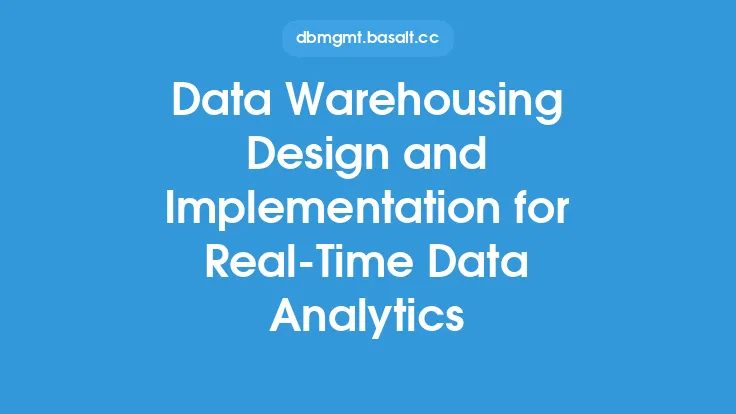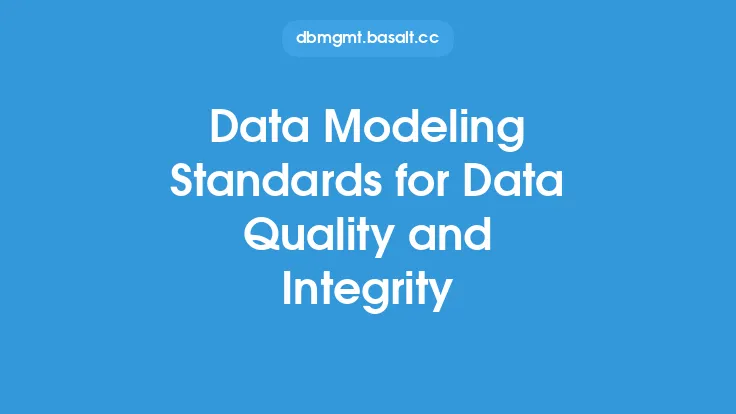When designing a data warehouse, one of the most critical aspects to consider is data quality and integrity. A well-designed data warehouse should ensure that the data stored is accurate, complete, and consistent, and that it can be trusted to support business decision-making. In this article, we will explore the key design considerations for ensuring data quality and integrity in a data warehouse.
Introduction to Data Quality and Integrity
Data quality refers to the accuracy, completeness, and consistency of the data stored in the data warehouse. Data integrity, on the other hand, refers to the assurance that the data is not corrupted or altered during storage or transmission. Ensuring data quality and integrity is crucial because it directly impacts the reliability of the insights and decisions made based on the data. Poor data quality can lead to incorrect analysis, flawed decision-making, and ultimately, business losses.
Data Warehousing Design Considerations for Data Quality
To ensure data quality, several design considerations must be taken into account. First, the data warehouse should be designed to handle data from multiple sources, including internal and external sources. This requires implementing data validation and cleansing processes to ensure that the data is accurate and consistent. Additionally, the data warehouse should be designed to handle data transformations, such as aggregations and calculations, to ensure that the data is properly formatted for analysis.
Another critical consideration is data normalization, which involves organizing the data into a standardized format to minimize data redundancy and improve data integrity. Normalization also helps to ensure that the data is scalable and can be easily maintained. Furthermore, the data warehouse should be designed to handle data lineage, which involves tracking the origin and history of the data to ensure that it can be trusted.
Data Integrity Considerations
To ensure data integrity, several design considerations must be taken into account. First, the data warehouse should be designed with robust security measures to prevent unauthorized access and data corruption. This includes implementing access controls, encryption, and auditing mechanisms to detect and prevent data breaches.
Another critical consideration is data backup and recovery, which involves creating regular backups of the data and implementing a disaster recovery plan to ensure that the data can be restored in case of a failure. Additionally, the data warehouse should be designed to handle data replication, which involves creating multiple copies of the data to ensure that it is available and can be recovered in case of a failure.
Data Validation and Cleansing
Data validation and cleansing are critical components of ensuring data quality and integrity. Data validation involves checking the data for errors and inconsistencies, such as invalid or missing values, and ensuring that it conforms to the expected format. Data cleansing, on the other hand, involves correcting or removing errors and inconsistencies in the data.
To implement data validation and cleansing, several techniques can be used, including data profiling, data quality metrics, and data cleansing algorithms. Data profiling involves analyzing the data to identify patterns and anomalies, while data quality metrics involve measuring the accuracy and completeness of the data. Data cleansing algorithms, such as data normalization and data transformation, can be used to correct errors and inconsistencies in the data.
Data Governance and Metadata Management
Data governance and metadata management are critical components of ensuring data quality and integrity. Data governance involves establishing policies and procedures for managing the data, including data access, data security, and data quality. Metadata management, on the other hand, involves managing the metadata associated with the data, such as data definitions, data formats, and data lineage.
To implement data governance and metadata management, several techniques can be used, including data catalogs, data dictionaries, and metadata repositories. Data catalogs involve creating a centralized repository of metadata, while data dictionaries involve creating a standardized vocabulary for describing the data. Metadata repositories, such as data warehouses and data lakes, can be used to store and manage the metadata associated with the data.
Best Practices for Ensuring Data Quality and Integrity
To ensure data quality and integrity, several best practices can be followed. First, establish a data governance framework that outlines the policies and procedures for managing the data. Second, implement data validation and cleansing processes to ensure that the data is accurate and consistent. Third, use data normalization and data transformation techniques to ensure that the data is properly formatted for analysis.
Additionally, implement robust security measures to prevent unauthorized access and data corruption. Use data backup and recovery techniques to ensure that the data can be restored in case of a failure. Finally, use data replication and data distribution techniques to ensure that the data is available and can be accessed by authorized users.
Conclusion
In conclusion, ensuring data quality and integrity is critical for a data warehouse to support business decision-making. By considering the design considerations outlined in this article, including data quality, data integrity, data validation and cleansing, data governance, and metadata management, organizations can ensure that their data warehouse is designed to provide accurate, complete, and consistent data. By following best practices and using techniques such as data normalization, data transformation, and data replication, organizations can ensure that their data warehouse is scalable, maintainable, and secure. Ultimately, a well-designed data warehouse with high-quality and integrity data is essential for supporting data-driven decision-making and driving business success.





